Data Byte
Estimated time to complete: 1 hour
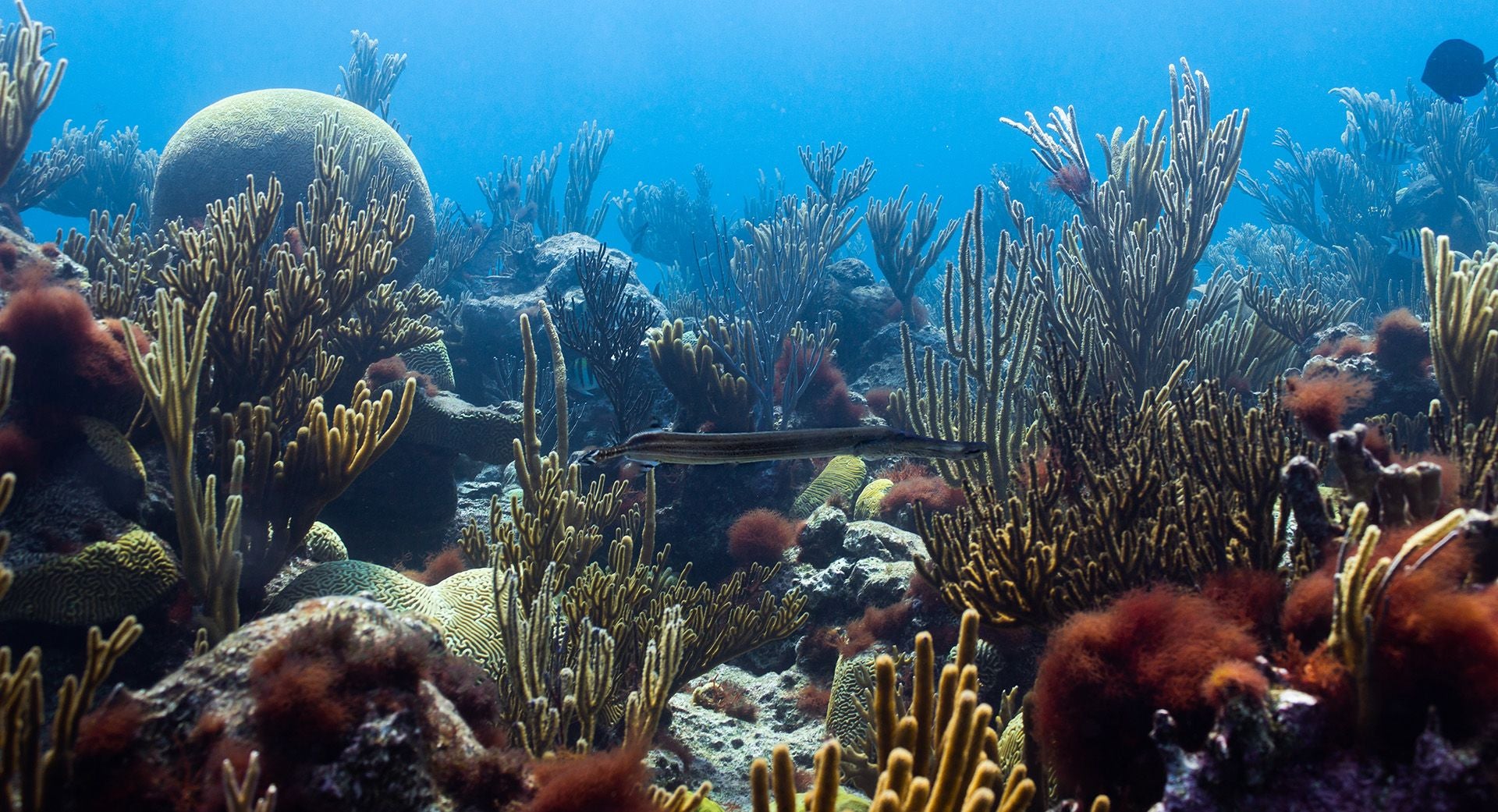
Estimated time to complete: 1 hour
Coral polyps go through cellular respiration, where the coral takes in oxygen and produces carbon dioxide. Zooxanthellae, a microscopic algae that lives in coral tissue, uses this carbon dioxide [produced by the polyp] to carry out photosynthesis, providing the coral with energy and releasing oxygen into the ocean.
In this activity students will learn how to calculate the Net Photosynthetic Rate (NP) in an individual coral colony.
Net Photosynthetic Rate (NP) is measured in µmol O₂ / cm² / hour. This numerical value represents the amount of oxygen produced by photosynthesis minus the oxygen consumed during respiration over a given time and area of coral tissue. This value provides a measure of the coral’s overall energy production from its symbiotic algae (zooxanthellae) in relation to its energy usage.
µmol O₂ : Micromoles of oxygen (O₂), indicating the amount of oxygen produced or consumed.
cm² : Per square centimeter of surface area of the coral
hour : Per hour, indicating the rate of oxygen exchange over time.
Scientists can monitor oxygen production utilizing incubation chambers. An incubation chamber is a sealed controlled environment with controlled conditions like light, temperature and water flow to mimic a coral’s natural environment. Specialized sensors track oxygen levels inside the chamber to monitor the oxygen production of coral’s zooxanthellae during photosynthesis, and oxygen utilization during cellular respiration of both the zooxanthellae and coral animal. Utilizing the measurements of oxygen within 6 liter chambers over various time points, scientists can better understand energy production within a coral colony or fragment.
Gross Photosynthetic Rate (GPR): The total amount of oxygen produced (or CO₂ fixed) through photosynthesis by zooxanthellae and any additional photosynthesis within the chamber.
Respiration Rate (RR): The oxygen consumed (or CO₂ released) during cellular respiration by the coral, zooxanthellae and any additional organisms within the incubation chamber.
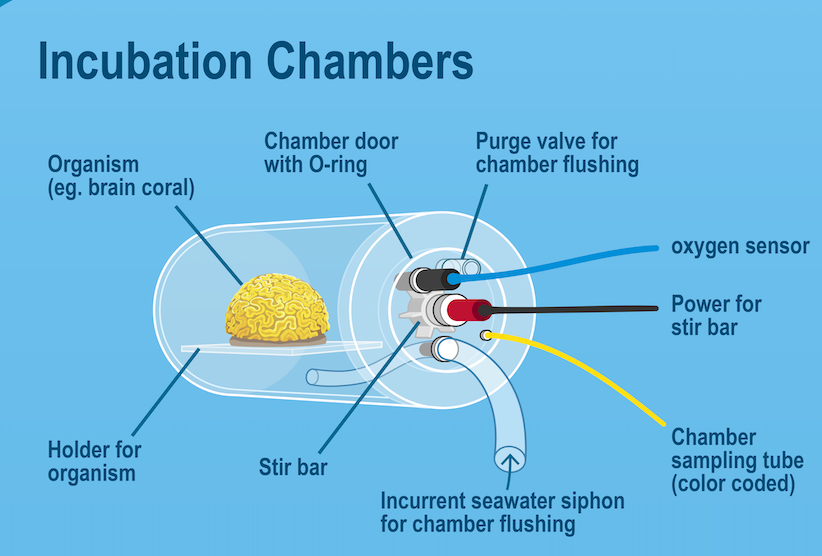
Download the Datasheet which is to be filled out throughout the DataByte module. This datasheet can be completed in Google Sheets, Microsoft Excel, or Microsoft Word format. The user will need to create an individual copy of the datasheet and save it as databyte_datasheet_yourinitials.xls.
Scientists took 5 coral colonies from the same species, the grooved brain coral (Diploria labyrinthiformis), on the same reef to study net photosynthetic rates. Each coral sample was placed into an incubation chamber for set time periods to monitor oxygen inside each incubation chamber and determine net rates of photosynthesis.
On July 23, 2022, scientists recorded oxygen concentrations every minute for 30 minutes in each of the 5 coral chambers. The data used in this lab is a subset of a long-term monitoring project.
The digital graph allows for the exploration of this data. Hover the mouse over the data points to see the oxygen concentration (O2) for each coral at that measured time point alongside the corrected slope.
The digital graph below allows for the exploration of this data. Hover the mouse over the data points to see the oxygen concentration (O2) for each coral at that measured time point alongside the corrected slope.
The slope of each line across the elapsed time is a reflection of the ratio of the vertical change (rise) to the horizontal change (run) between two points on a line.
The slope of the line between the two points represents the rate of oxygen production or consumption within the chamber.
A positive slope indicates oxygen is being produced (photosynthesis > respiration)
A negative slope indicates oxygen is being consumed (respiration > photosynthesis)
The steeper the slope, the faster the rate of production or consumption of oxygen within the chamber.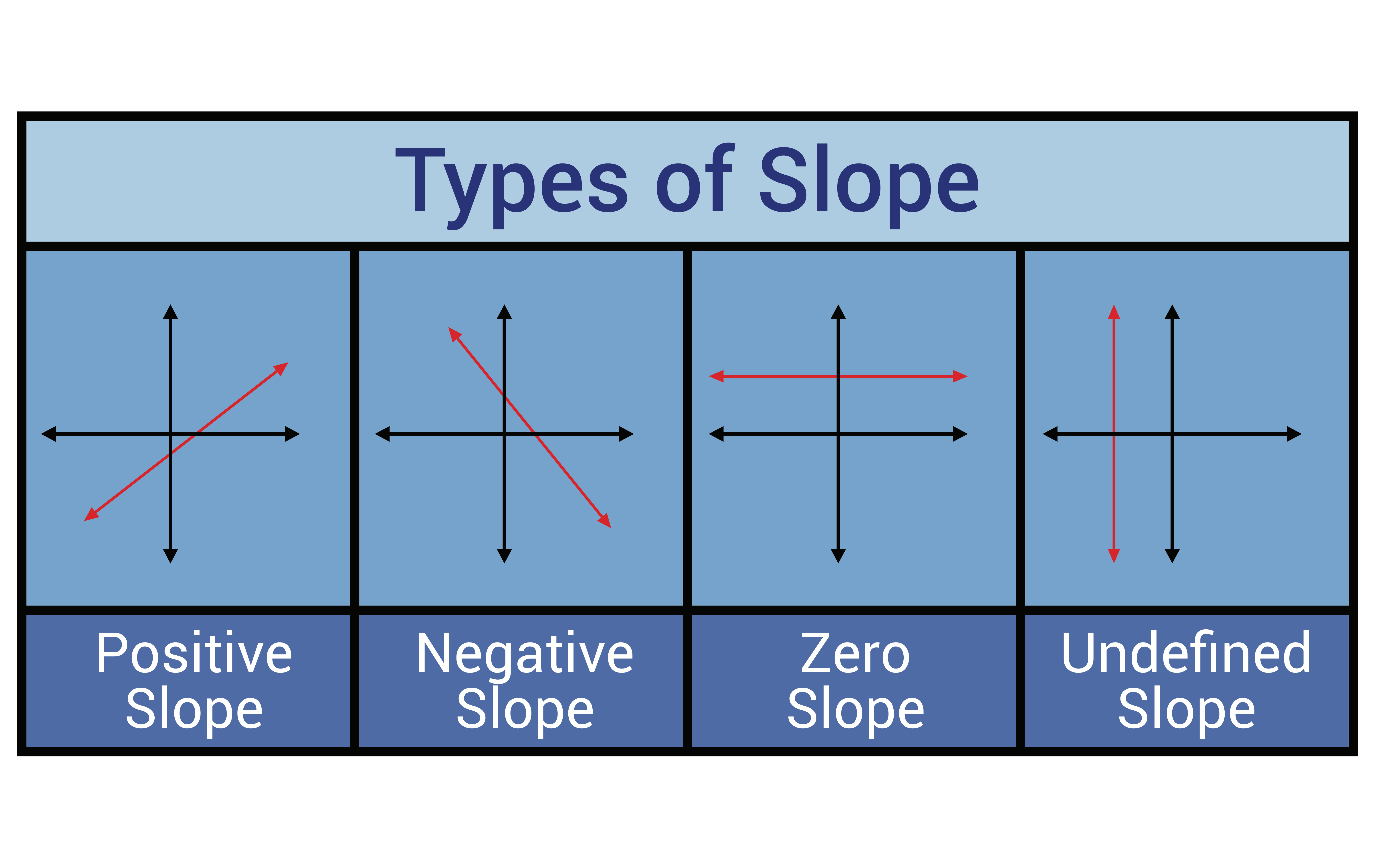
Corals are not the only organisms within the incubation chambers that undergo cellular respiration and photosynthesis. Microscopic plankton floating in the water column also consume and produce oxygen. To account for this, scientists have one incubation chamber blank encapsulating 6 liters of seawater. The oxygen concentration was also calculated every 30 minutes within the blank chamber.
In the digital graph, the values from this “blank” chamber were subtracted from the oxygen concentration rates for corals 1-5, resulting in the “corrected slope.” Record the “corrected slope” for each coral (1-5) in the datasheet.
Building on skills learned in the DataTaste, ImageJ will be used to measure the diameter of each coral colony and determine the surface area. If the DataTaste has not been completed, please refer to steps 1-3 in the DataTaste ahead of completing this step.
To conduct an investigation into coral surface area, save the image of coral_1 to your computer using the file name coral_1.jpg. Open the downloaded file in ImageJ to verify it matches the image below.
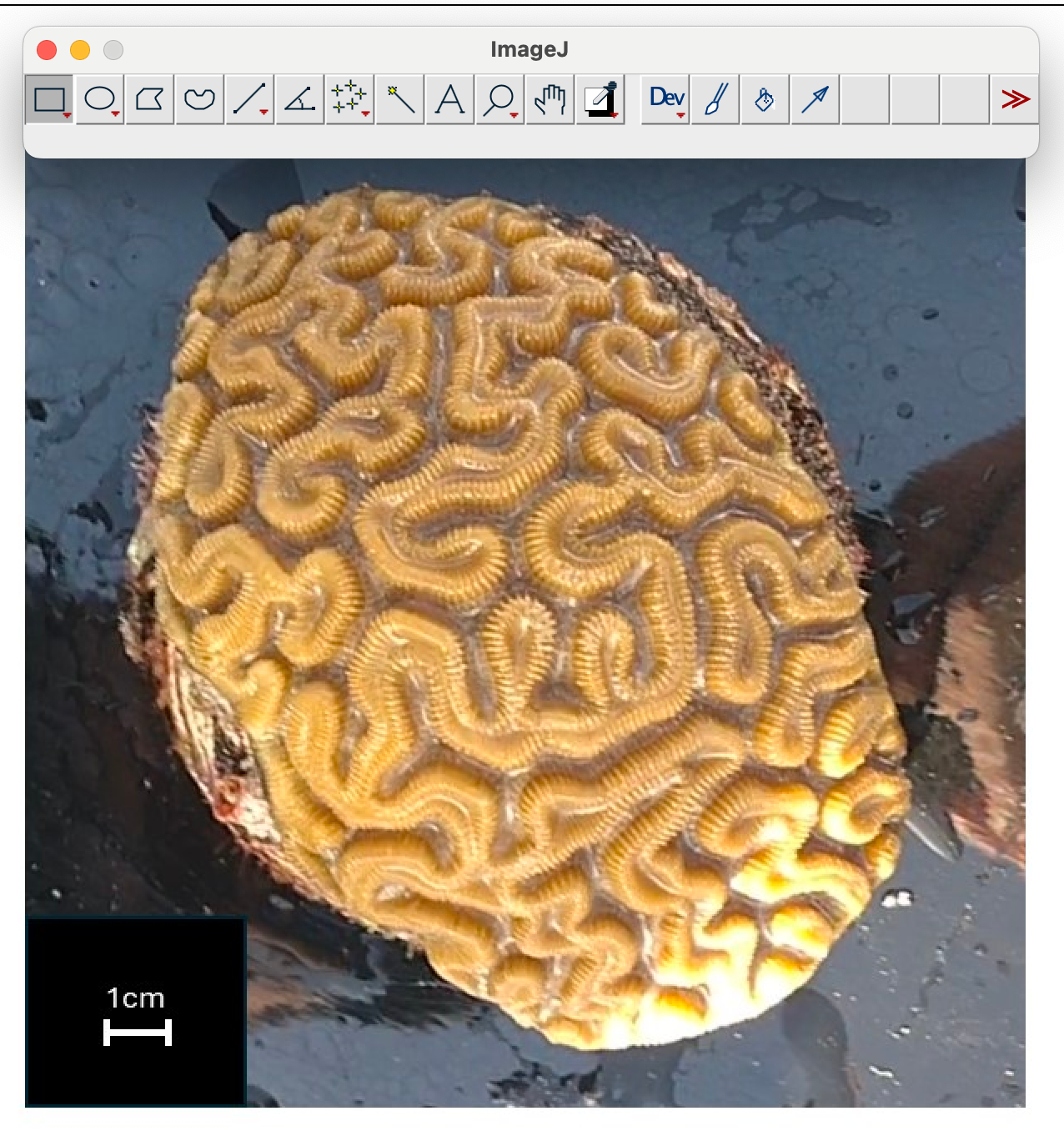
Navigate to the scale bar in the bottom left hand corner of the image.

Next, navigate the toolbar to select the straight line tool and select.

Navigate to the scale bar within the image to create a straight line directly on top of the entire length of the scale bar.
| The magnifying glass tool on the toolbar can be utilized for zooming in. | |
| The scrolling hand tool on the toolbar can be used to additionally move the image. |
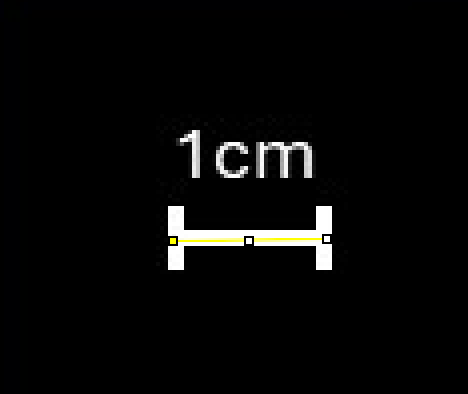
Navigate to Analyze → Set Scale in Image J. This feature will take the number of pixels that make up the line of the scale and equate this with a known distance. The known distance from the scale bar is 1cm. Ensure the known distance is set to “1” and the unit of length is cm, or the unit listed in the scale bar. Tick the box marked “global” which will save this scale until the user updates it. Distances in pixels will vary slightly between individuals but should range between 40 and 42 pixels.

The diameter of a circle is the straight line segment that passes through the center of the circle and connects two points on its boundary. It is the longest straight line that can be drawn.
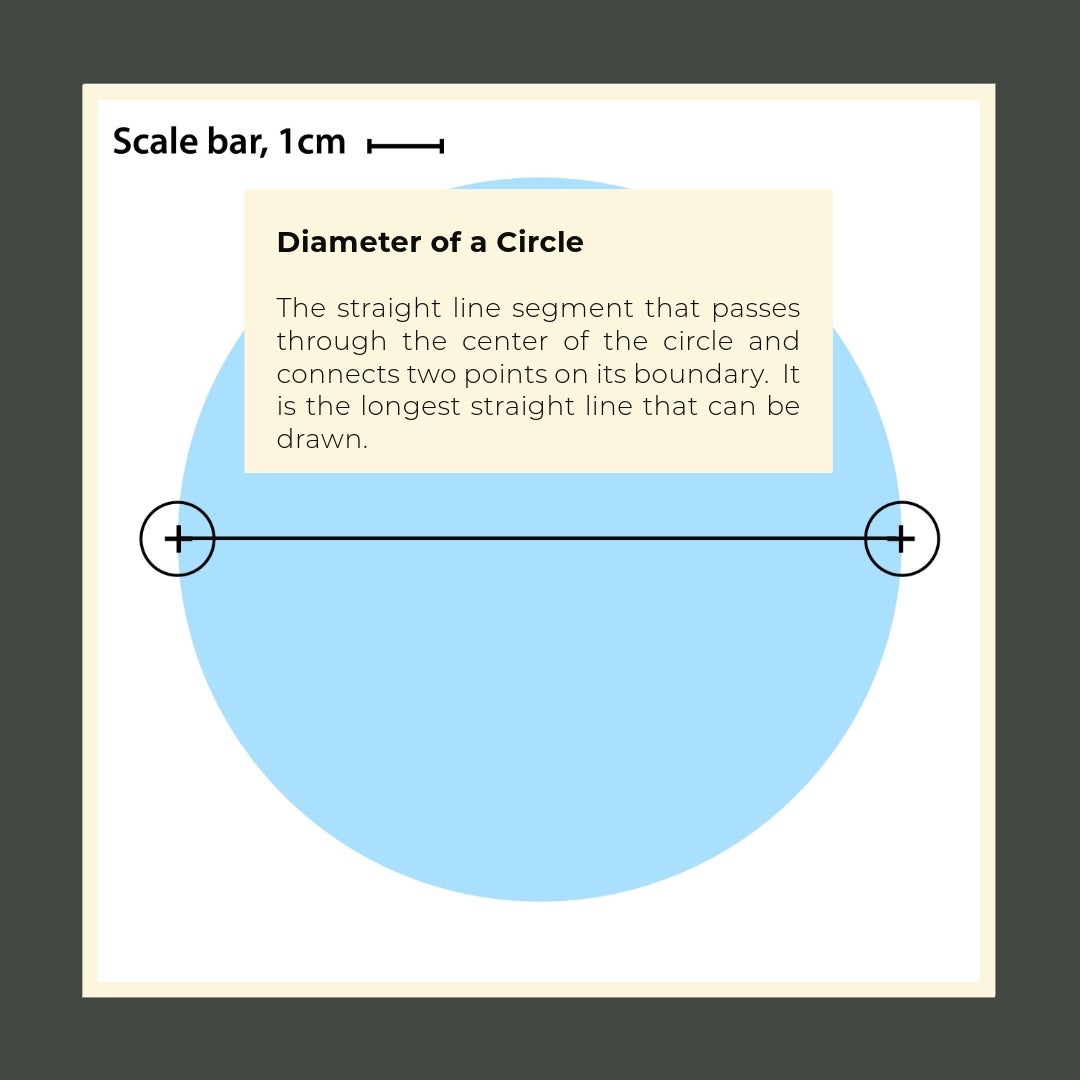
Once the scale is set, the diameter can be measured using the Analyze → Measure function. The coral is not perfectly round, so be sure to measure across the coral image in 4 different diameters. Take 4 coral diameter measurements from one end of the coral image to the other.
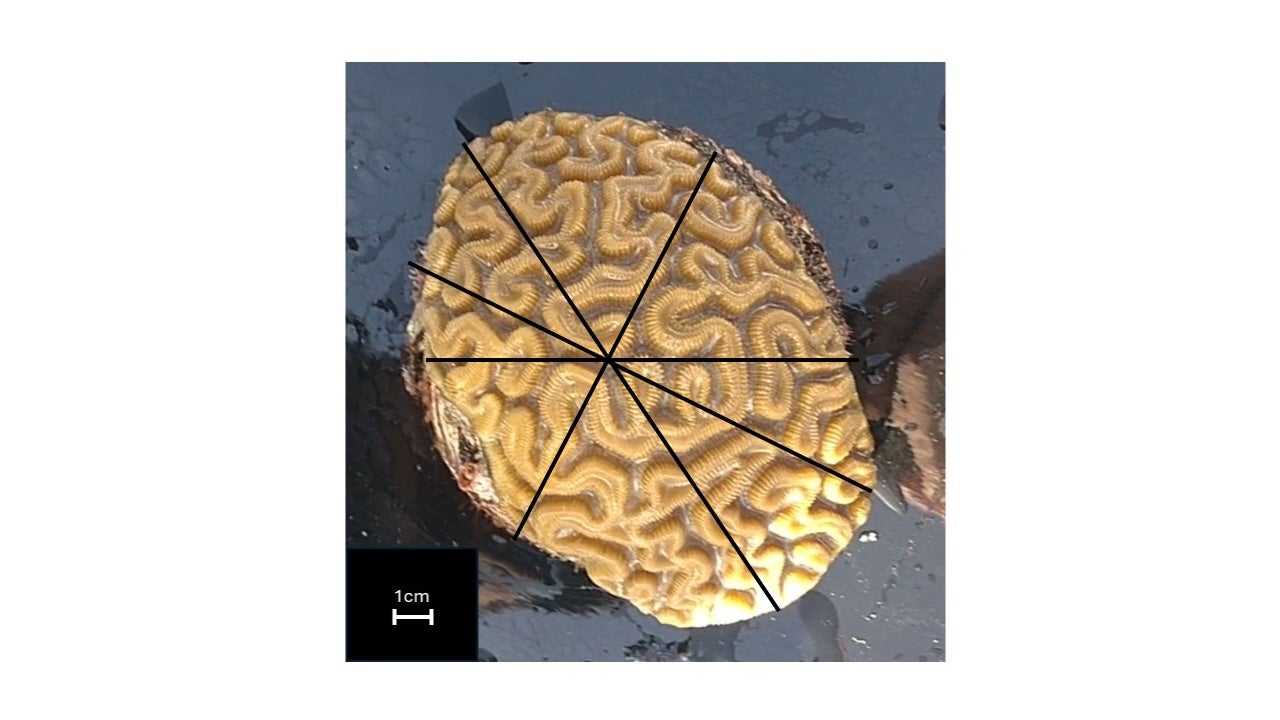
| The magnifying glass tool on the toolbar can be utilized for zooming into the coral for the most accurate measurement. | |
| The scrolling hand tool on the toolbar can be used to additionally move the image from year to year. | |
 | The line tool will switch back to make the measurement mode. |
After recording 4 measurements of the coral image, navigate to Analyze → Summarize. This feature will summarize the minimum, maximum, mean (average), and standard deviation of measurements taken.
The mean value of the Length column represents the average diameter length of the coral.
Navigate to the master datasheet and record this number under Coral ID 1, Average Diameter. This number will be utilized to calculate the surface area of each of the 5 corals. In the example below the average diameter (length column) is 12.035 cm.

Repeat steps 5-8 for each of the additional coral images. Download and save the images for corals 2, 3, 4, and 5. Measure the diameter(s) in ImageJ and find the average diameter length (cm) for each coral.
Record the average diameter length (cm) of each coral in the master datasheet.
The average diameter of each coral (cm) should range between 12.0 cm and 15.0 cm. At the conclusion of this step, two columns in the master datasheet should now be complete (Average Diameter and Slope).
The radius of a circle is a straight line from the center of the circle to its edge. It is equal to half the length of the diameter.

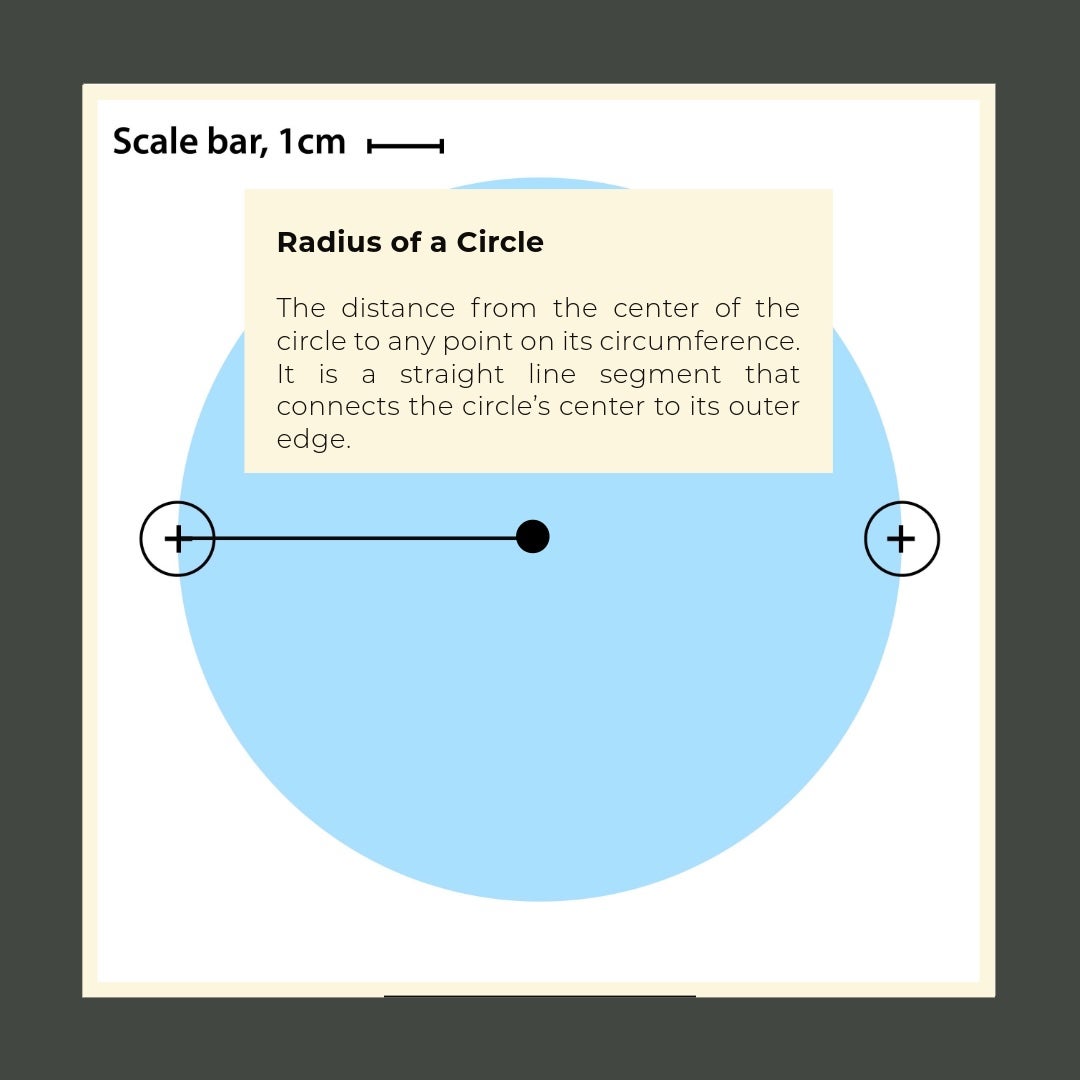
Utilizing the average diameter data for each coral, divide the diameter by 2 to determine the average radius (cm) for each of the 5 coral colonies. Record these values in the datasheet.
While these 5 coral colonies are all the same species (Diploria labyrinthiformis), they are each genetically distinct and have different sizes, shapes, and rates of net photosynthesis. Calculating the surface area of each coral will account for these differences to standardize the average photosynthetic rates by a common metric.
To calculate the surface area of each coral colony, assume that the coral is spherical and in the shape of a half ball. The equation surface area (SA) = 4 x π x radius (r)2 is used to calculate the surface area of a sphere, which is divided by 2 to calculate the surface area of half a sphere.
Plug the average radius of each coral into the following equation to calculate the surface area of each coral colony.
surface area (SA)= 4 x π x radius (r)2
Record the surface area for corals 1-5 in the datasheet. Because the radius is measured in centimeters (cm), the surface area is measured in square centimeters ( cm2).
In Excel the pi function is noted as pi()
Pi is equal to 3.14159265359
Example:
If the average diameter of coral 1 was 12.035, the radius would be 6.108 and the formula to calculate the surface area of this coral would be:
surface area (SA) = 2 x 3.14159265359 x (6.108)2 = 227.516 cm2
In this step we will be utilizing the values in the data worksheet to calculate the net photosynthetic rate.
If a coral is in net photosynthesis, it is producing more oxygen [during photosynthesis] than it is using [for cellular respiration], meaning that it is gaining energy. This energy is critical for coral metabolism, including processes driven and regulated by coral metabolism, including calcification.
Use the following equation to calculate the net photosynthetic rate (NP) for coral 1. Use the datasheet to plug in the values for the slope and surface area of corals 1-5. The volume of water inside each incubation chamber was 6 liters.

Net photosynthesis is recorded as the rate of photosynthesis per hour, but slope was measured as a rate per minute. To convert from minutes to hours, the equation multiplies the values by 60.
Record the NP of coral 1 in the final column on the datasheet. The unit for NP is µmol O2 / cm2 hour.
Repeat this process for corals 2-5 by plugging their respective slopes and surface areas into the equation above. Record the NP for each coral on the datasheet.
The final datasheet should look within range of the below.
Note: the values for the diameter, radius, and surface area will differ depending on the measurements conducted in ImageJ, resulting in small differences in the net photosynthetic rate (NP).
Coral ID | Average Diameter [cm] | Radius (r) [cm] | Surface Area [cm2] | Corrected Slope [O2/min] | Volume [L] | Net Photosynthetic Rate (NP) [µmol O2 / cm2 hour] |
1 | 12.035 | 6.018 | 227.516 | 0.460 | 6 | 0.728 |
2 | 12.143 | 6.072 | 231.618 | 0.820 | 6 | 1.275 |
3 | 14.572 | 7.286 | 333.548 | 0.810 | 6 | 0.874 |
4 | 12.052 | 6.026 | 228.159 | 0.610 | 6 | 0.962 |
5 | 14.552 | 7.276 | 332.633 | 0.720 | 6 | 0.779 |
Calculating the coral net photosynthetic rate is an invaluable tool for understanding how much remaining energy is within the coral animal after respiration. This remaining energy can be utilized for growth (calcification), reproduction, or storage. By analyzing photosynthetic rates, scientists can better understand seasonal and temporal trends across species.
In this final step, basic descriptive statistics will be calculated using the Formula Bar. Please see Step 8 in the DataTaste for more guidance.
The =AVERAGE function in Excel is used to calculate the mean of a set of numbers or values. It adds up all the numbers in a given range and then divides the sum by the total number of values in that range. The “=” sign indicates in Excel that a function is being utilized. The function AVERAGE is entered and next an open parenthesis is added “(“. The user can then highlight all of the 5 net photosynthetic rate (NP) values and then close the parentheses “)” and hit “Enter”.
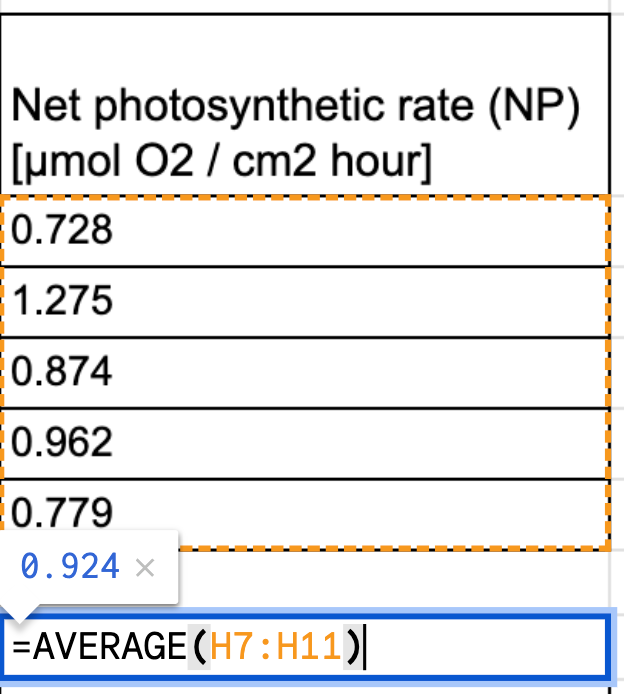
=AVERAGE(H7:H11)
The =STDEV function in Excel will be used to calculate the standard deviation (s) around the mean, which is a measure of how spread or dispersed the values in a dataset are around the mean (average). This value shows the average distance of a data point from the mean, which indicates variability or consistency of the data. The “=” sign indicates in Excel that a function is being utilized. The function STDEV is entered and next an open parenthesis is added “(“. The user can then highlight all of the 5 net photosynthetic rate (NP) values and then close the parentheses “)” and hit “Enter”.
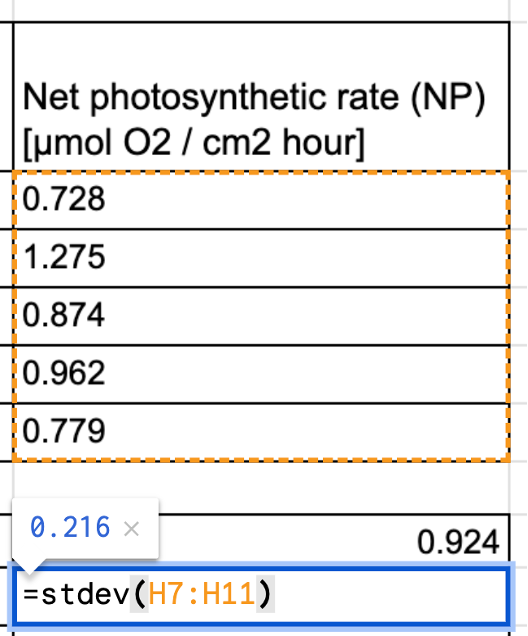
=STDEV(H7:H11)
The standard error (SE) is a measure of how much the sample mean is likely to vary from the true population mean and takes into account the sample size.
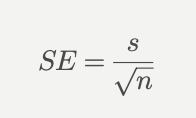
SE : Standard error of the mean.
s : Sample standard deviation
n : Sample size (number of observations)
=H14/SQRT(5)
Noting here that “s” has already been calculated in the previous step (cell H14) and noting that the sample size is the number of corals observed for net photosynthetic rate (NP), which is 5.
Each final average will vary based on individual calculations, and in this example the reported final value average is:
0.924 ± 0.096 [µmol O2 / cm2 hour]
Coral net photosynthetic rate is a tool for understanding what the remaining energy is within the coral animal after respiration that can be utilized for growth (calcification), reproduction, or storage. Use this graph to compare data collected in this lab to research experiments collected in the summer of 2022 within laboratory incubation chambers located at the Bermuda Marine Mesocosm Facility on the ASU Bermuda Institute of Ocean Sciences campus.
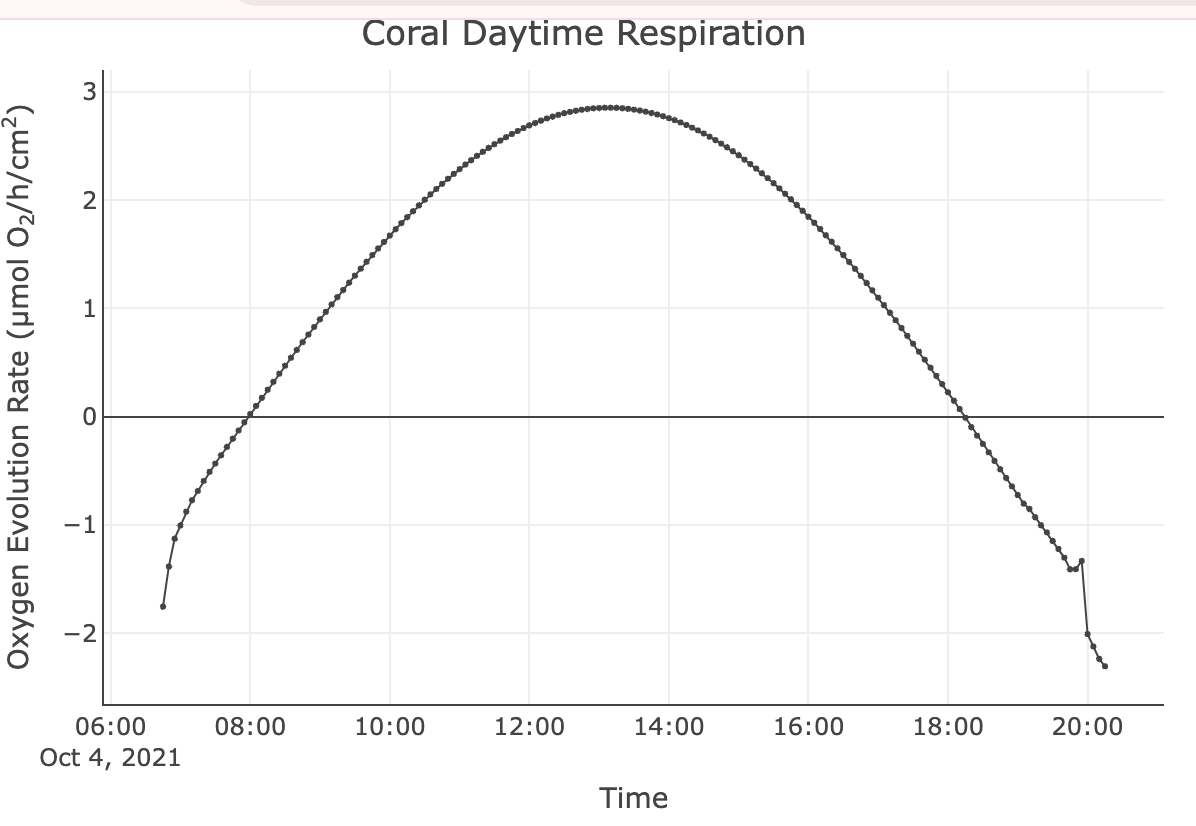
What are some abiotic factors that could influence the net photosynthetic rate of a coral over the course of a day and season?
Utilize the below resources to create a one-page summary outlining reasons why there could be seasonal differences in NP for Diploria labyrinthiformis in Bermuda.